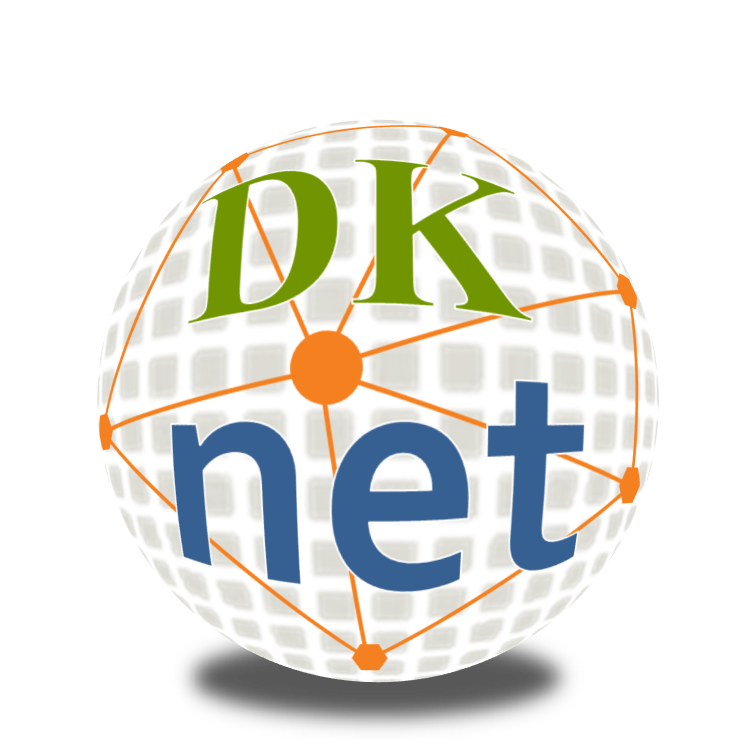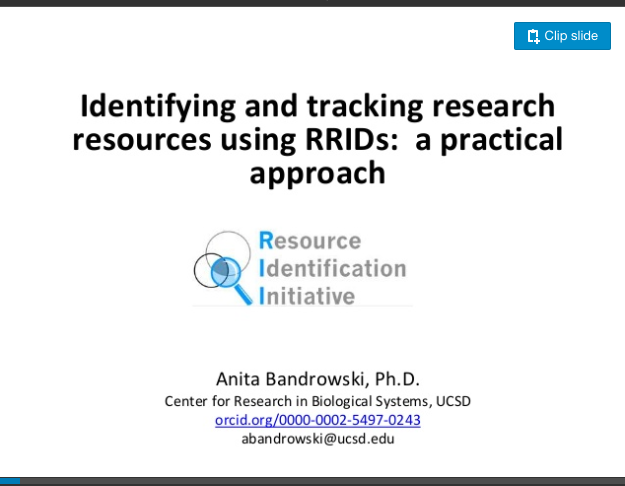Leaving Community
Are you sure you want to leave this community? Leaving the community will revoke any permissions you have been granted in this community.
Research Resource Identifier (RRID)
The NIH Policy on Rigor and Reproducibility was released in the fall of 2015. Since 2016, researchers have been required to attach a form titled "Authentication of Key Biological and/or Chemical Resources" with research grant submissions. You may have grumbled, "I'm already extremely busy, what's with the new step?." As the beleaguered mumbles of grant writing woes rolled off your tongue, you may have also noticed "RRID:" in the Methods section of the latest scientific literature. Maybe you even received a letter from reviewers and journal editors requesting RRID tags for your resources before they published your study. The dkNET team has developed several tools and services to help researchers, like yourself, comply with NIH grant submission policies and journal requirements. Compliance will increase the reproducibility of research in scientific community. This article will develop your understanding of what RRID is and how using RRID can help your research!
3. Why is using RRIDs important?
4. What can you do with an RRID and how can dkNET help you?
5. dkNET + RRID ecosystem helps monitor the health of the scientific food chain
1. What are RRIDs?
RRIDs are meant to improve the standards of research resource reporting in order to support rigor and reproducibility. RRID's original concept was envisioned during NIH meetings in 2010-2011. These meetings, which were hosted by NIH’s National Center for Research Resources, involved the development of an initial white paper on resource identification by principal investigators for dkNET (Drs. Maryann Martone and Jeffrey Grethe) and the current lead for the RRID project (Dr. Anita Bandrowski). This white paper was posted in 2012. The Research Resource Initiative was then started by Dr. Maryann Martone, through the Neuroscience Information Framework (NIF). Initially, meetings with publishers from 2011-2013 (hosted by NIF, NIH’s NIDA and the International Neuroinformatics Coordinating Facility (INCF) were held to discuss the problem of research resource identification. From the potential solutions discussed in these meetings, a pilot project was born. This project was started in 2014 and led by Drs. Martone and Bandrowski. It was initiated through FORCE11 with leverage, infrastructure, and support from dkNET. Through this framework from dkNET, the initial RRID portal was created. The pilot included additional partners (i.e. the Oregon Health & Science University Library and the Monarch Initiative). In 2015, the pilot project concluded. A publication describing how RRIDs were being used by authors in 100 papers from 20 journals was released. The publication described how the use of RRIDs was showing potential for benefiting the accurate reproducibility of research in the scientific community. In respect to this potential, RRIDs are currently being used in over 340 journals (August, 2017). The RRID project is supported by leadership of Dr. Anita Bandrowski and works in collaboration with SciCrunch, NIF, and dkNET.
RRIDs are persistent and unique identifiers for referencing a research resource and are used for promoting research resource identification and tracking. Catalog numbers change, disappear or can be reused for another resource, but RRIDs always resolve to the same research resource and endure beyond the existence of the research resource itself. It’s an easy and practical method for improving reproducibility, transparency and tracking.
Examples of RRIDs:
- Antibody: Estrogen receptor beta antibody, RRID:AB_10618531
- Cell line: HK-2 [Human kidney], RRID:CVCL_0302
- Mouse model: TSOD.C-Nidd6, RRID:IMSR_-CARD:280
Software: ANOVA, RRID:SCR_002427
2. Why do we need RRIDs?
During the publication process, reported resource identifying information is typically lacking. Furthermore, no standard way of referencing a resource in a paper or grant has been implemented. This makes it a serious challenge for human or machine to identify the exact resources. Let's do a quick search using dkNET: by searching "estrogen receptor beta antibody", there are more than 100 antibodies in the results with the same antibody name. If only the antibody name is cited in a paper or grant, with no identifying tag, there is no viable way for a fellow researcher to know which antibody was specifically used in the mentioned context. This hinders their ability reproduce or further research the experiments cited in the paper or grant. Catalog numbers are sometimes mentioned with the name of an antibody in order to add some kind of specificity. However, these numbers are subject to numerous changes in the information they actually provide. Outside (often financially driven) forces such as the merging of companies, the restructuring of resource stock, or the closing of a certain manufacturer can greatly alter, or render completely inaccurate, the catalog number associated with an antibody at the time it was cited in a publication. The solution lies with RRID, a unique identifier for research resources. Providing uniformity in regards to citation and taking, RRIDs are being adopted by many players involved in reproducibility in the scientific community to solve the problem of keeping resources reproducible and identifiable.
3. Why is using RRIDs important?
RRID is a unique and stable identifier for a single research resource. RRID indicates use of a research resource, not simply a mention. Again, using RRIDs in papers or grants allows researchers to identify the resources used in the studies, and it's a simple way to improve reproducibility and transparency. Use of RRIDs across journals is increasing. As of August, 2017, hundreds of journals request RRID citation to help fulfill NIH's guidelines for rigor and reproducibility. These journals include: Endocrine Society journals such as Journal of Endocrinology, American Journal of Physiology Gastrointestinal and Liver Physiology, Steroid Biochemistry and Molecular Biology, Journal of Hepatology, PNAS, The American Journal of Human Genetics, Cellular Signaling, Elsevier journals, BMC such as BMC Urology, Frontiers, Cell Press, eLife, and Wiley...etc.
Below: Number of journals per publisher using RRIDs (August, 2017):
Full list of journals using RRIDs (August, 2017)
RRID requirements listed in author instruction in Endocrinology: http://press.endocrine.org/page/endoita
"Registration of unique resources with RRID (Research Resource Identifiers) is recommended (see https://scicrunch.org/resources). If there are restrictions to the availability of such resources, authors must disclose this to the editors at the time of submission, and include a comment on the restrictions in the Materials and Methods section. The Endocrine Society endorses the philosophy of open exchange of research materials and requires this. The Editors may deny further publication rights in the journal to authors unwilling to abide by these principles."
Here is what RRIDs look like in journals:

4. What can you do with RRIDs and how can dkNET help you?
dkNET provides pipelines and services in regards to RRIDs. Furthermore, dkNET provides the user assistance in find and obtaining RRIDs. RRIDs can be used to identify and track your resource. Additionally you can aggregate data about your resource and generate authentication plans for it. All of these is to help you and scientific community to monitor the health of the scientific food chain.
dkNET makes it easy to find RRIDs by providing a single search portal. Over 25 databases are searched for RRIDs using dkNET technologies. These databases include:
- Antibodies: Antibodyregistry.org
- Cell lines: Cellosaurus
- Softwares and tools: SciCrunch:Registry
Model organism:
Ambystoma -AGSC
Mice - BCBC, CWRU Cystic Fibrosis Mouse Models, IMSR, MGI, MMRRC
Pig - NSRRC
Xenopus - NXR
Rat - RGD, Sperm Stem Cell Libraries for Biological Research
Tetrahymena - Tetrahymena Stock Center
Worms - WormBase
Xiphophorus -XGSC
Method 1. Find RRID at dkNET's Resource Report
Search for your resources at Resource Reports and find RRIDs that already exist for your resources. Search tip: use a vendor name and/or catalog number for antibodies and cell lines.

Method 2. Use the dkNET Authentication Report feature
In regards to grant submission, if you have a dkNET account, you can create a new authentication report and search for relevant resources using the search bar under "Search for your resources and add them to the report". This is located under Authentication Reports dashboard. After adding your resources, you can always come back to check RRIDs in the report.

Method 3. Use the Resource Identification Portal
You can also go to Resource Identification Portal directly to find RRIDs:
- Cell Lines: https://scicrunch.org/resources/Cell%20Lines/search?q=*
- Antibodies: https://scicrunch.org/resources/Antibodies/search?q=
- Specialty Chemicals: https://scicrunch.org/resources/about/guidelines#celllines: we currently do not have RRIDs for specialty chemicals. Please use source, catalog number, and PubChem CID for resource identification.
- Model Organisms: https://scicrunch.org/resources/Organisms/search?q=*
- Tools (Software, databases, services): https://scicrunch.org/resources/Tools/search?q=&l=
b. Obtain an RRID
If you can not find the RRID for your key resource, please reference these resource-specific search tips. If you have determined that the resource is not present, here are some suggestions that are provided by the Resource Identification Portal Community in order to help you to register your resource and obtain a unique identifier:
- Cell Lines: https://scicrunch.org/resources/about/guidelines#celllines
- Antibodies: http://antibodyregistry.org/add
- Model Organisms: https://scicrunch.org/resources/about/guidelines#organism
- Tools: suggest a resource to SciCrunch https://dknet.org/about/resource
Don't hesitate to contact rii-help@scicrunch.org if you need any help!
c. Use RRIDs to identify resources
When you see a resource cited with an RRID in an article or supplemental grant documents, this means that you can find additional metadata via dkNET about said resources. For example, if you find an antibody resource with the citation of RRID:AB_10547752, copy and paste "RRID:AB_10547752" to the dkNET search bar and search. Upon clicking on the resource name you will see the metadata that can help you to identify this antibody.

d. Use RRIDs to track resources
RRIDs allow for easy tracking of resources. Furthermore, they allows researchers to find out what other studies used the same resources in the literature. This can help researchers aggregate data across experiments regarding individual organisms and cell lines. This aggregation allows for troubleshooting experiments and communication of problems with research resources. Uniquely, this further allows funding agency to track the impact of their decisions.

e. Generate an authentication plan
The dkNET team has implemented an automated tool in order to assist grant submitters in generating authentication reports (this tool is in its beta version). In order to use this tool, open a dkNET account now (it's free!). Through integrating with RRID, dkNET allows researchers to find resources in dkNET and to transfer those resources to the individual's named project. dkNET can then generate an authentication report with RRIDs and information used for identification and authentication plan of all the resources in the researcher's project. The researcher can then use this document for grant applications. Other uses of the report could include keeping the document as authentication material for lab or publication use. The Authentication Report dashboard can also alert researchers about known problems with a given resource.

5. dkNET + RRID ecosystem helps monitor the health of the scientific food chain!
dkNET constantly updates its data sources in order to provide researchers with relevant information. Additionally, these constant updates provide insight in regards to resources that may be problematic. The collaboration of dkNET and RRID allows for researchers and reviewers to track research resources before, during, and after the study is conducted and published. In conjunction with researchers benefiting from alerts regarding their resources, reviewers and editors subsequently benefit from alerts in regards to manuscripts and grants that are submitted or reviewed. Additionally, article consumers can track resources that are mentioned in literature.
Including RRIDs in your paper and grant application will only benefit your scientific research. Start including them now! Let's make our science more rigor, reproducible and transparent!
6. References
- Bandrowski A et al. The Resource Identification Initiative: A cultural shift in publishing. Version F1000Res. 2015 May 29 [revised 2015 Nov 19]; 4(134). doi: 10.12688/f1000research.6555.2. eCollection 2015. PMID: 26594330
- Bandrowski AE and Martone ME. RRIDs: A simple Step toward Improving Reproducibility through Rigor and Transparency of Experimental Methods. Neuron. 2016 May 4; 90(3): 434-6. doi: 10.1016/j.neuron.2016.04.030. PMID: 27151636
- Bandrowski AE. Identifying and tracking research resources using RRIDs: a practical approach. 2017 Presentation slides.





